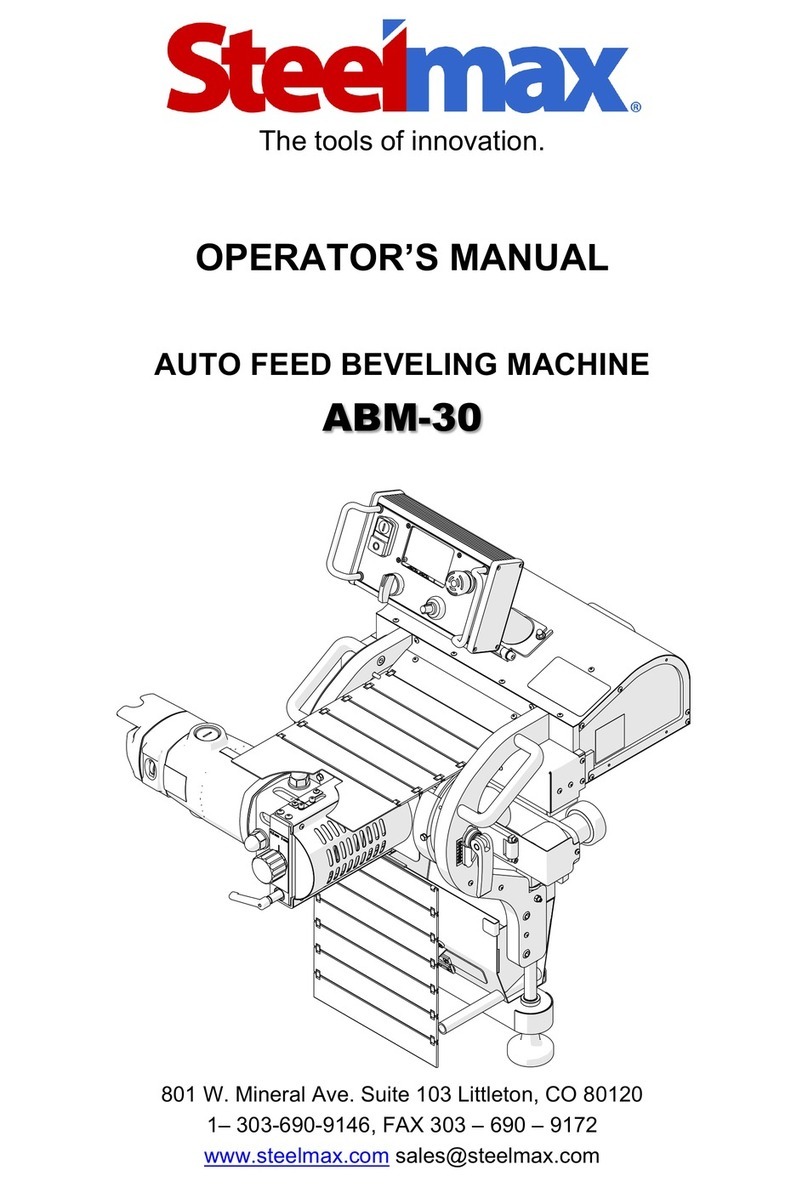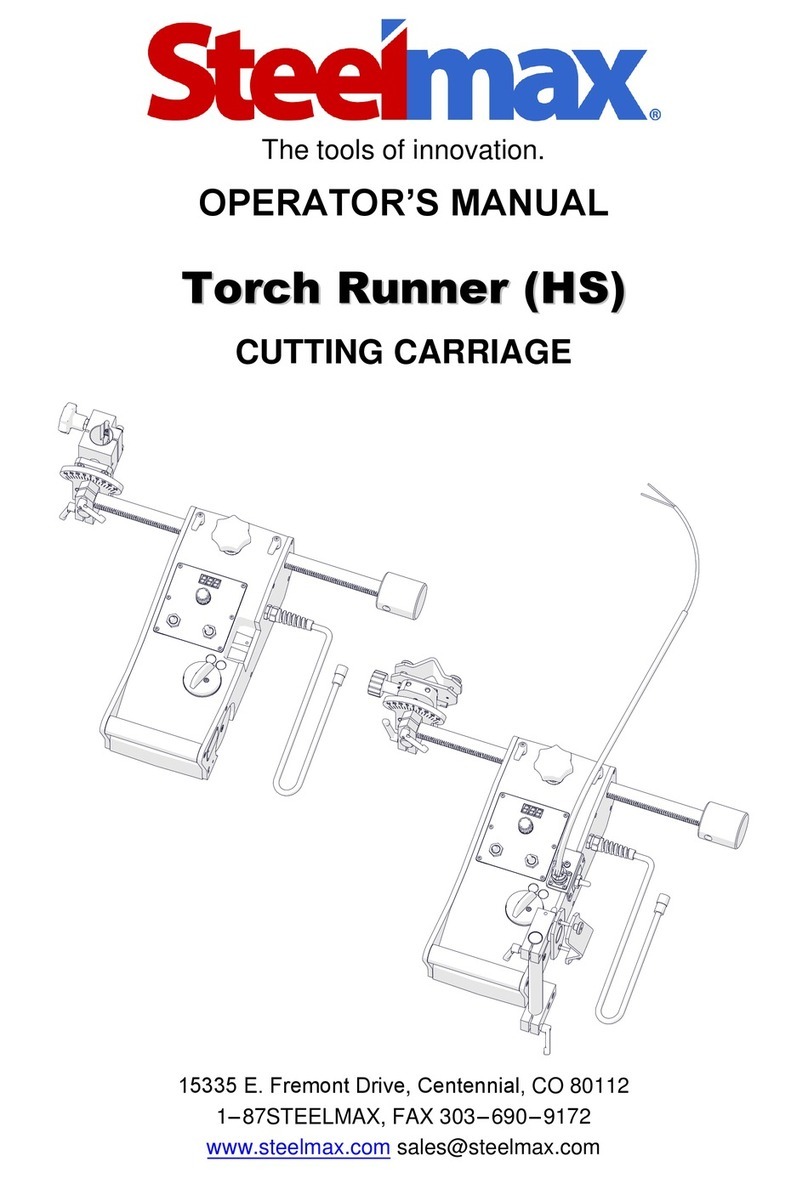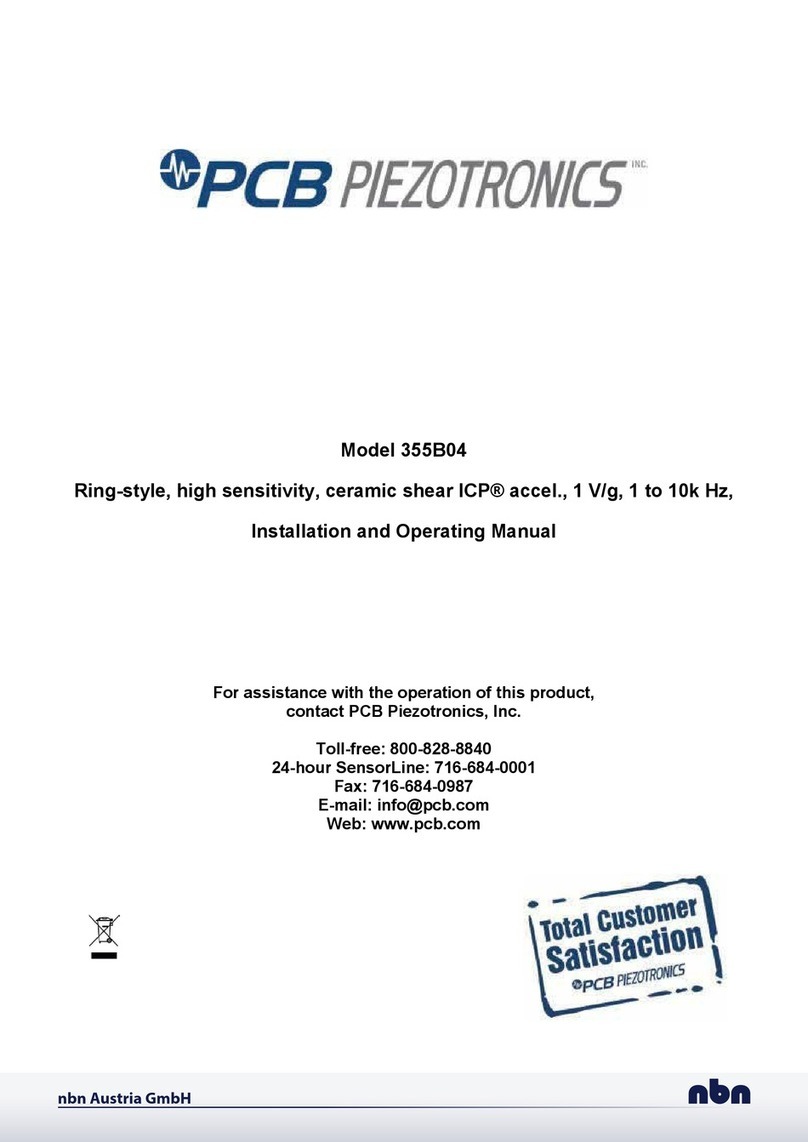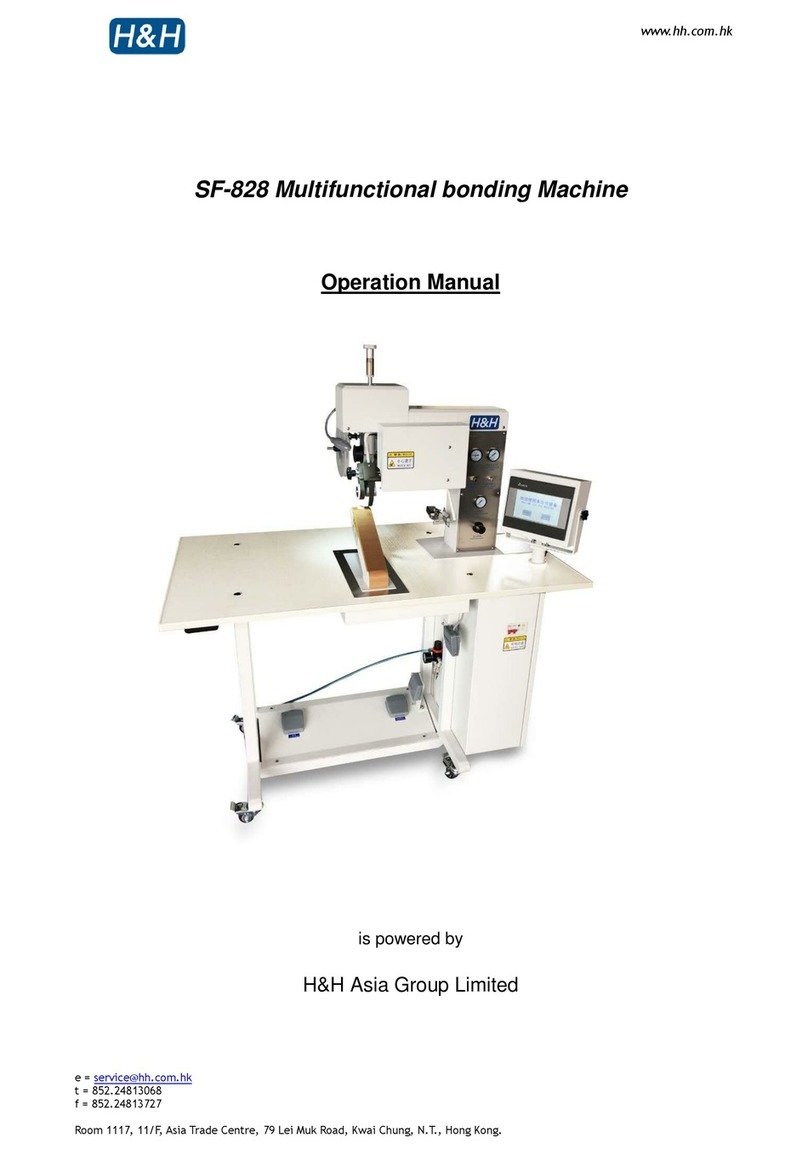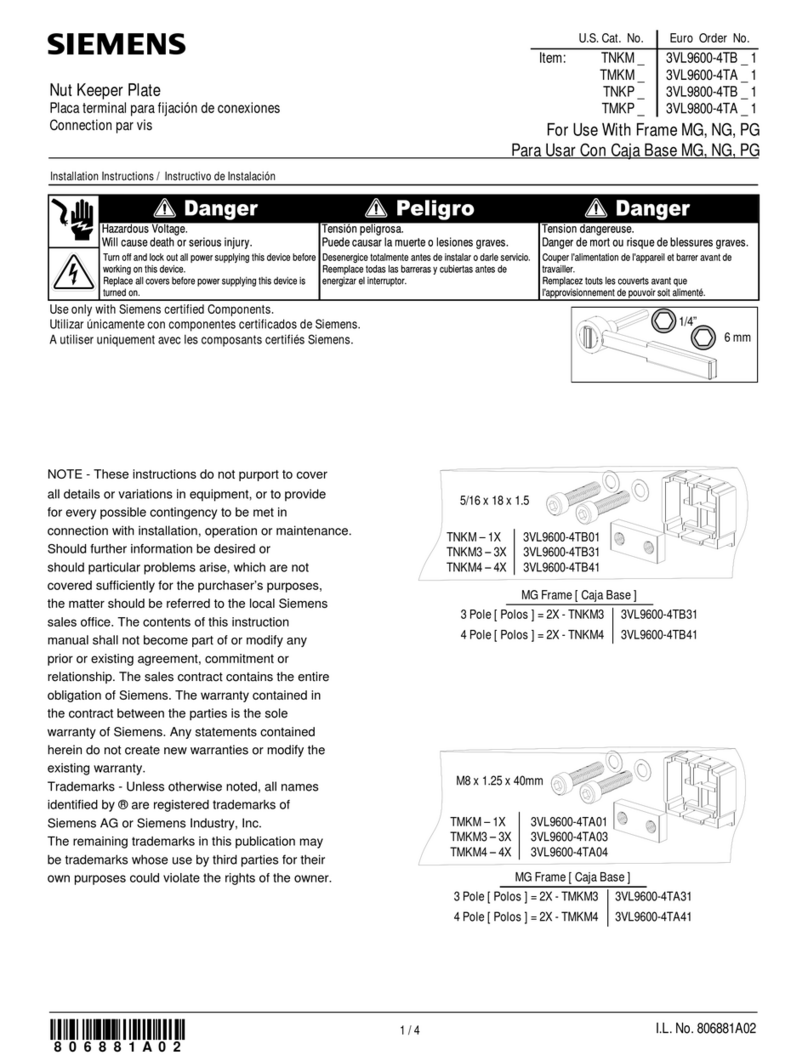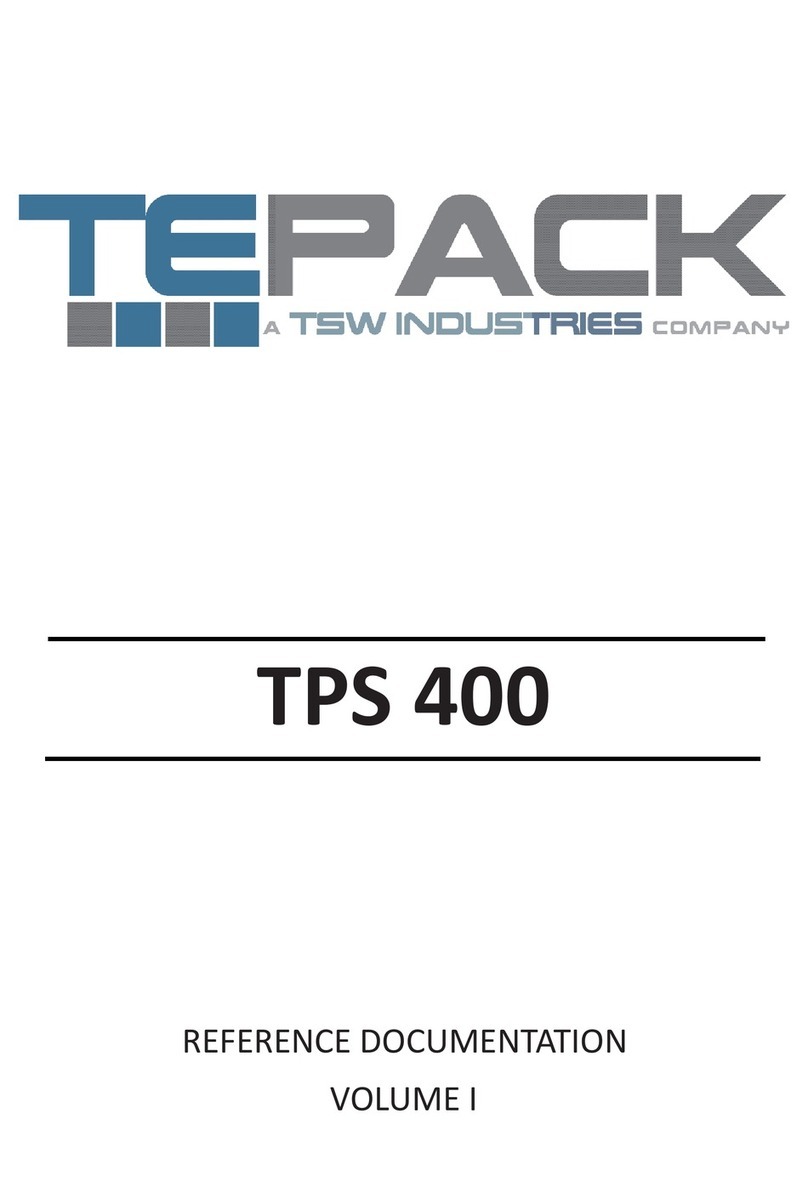SteelMax Rail Runner User manual

The tools of innovation.
15335 E. Fremont Drive, Centennial, CO 80112
1–87STEELMAX, FAX 303–690–9172
www.steelmax.com [email protected]
OPERATOR’S MANUAL
R
Ra
ai
il
l
R
Ru
un
nn
ne
er
r
WELDING CARRIAGE

Contents
1. GENERAL INFORMATION............................................................................................... 3
1.1. Application................................................................................................................. 3
1.2. Technical data............................................................................................................ 4
1.3. Equipment included ................................................................................................... 5
1.4. Dimensions................................................................................................................ 6
1.5. Design ....................................................................................................................... 7
2. SAFETY PRECAUTIONS.................................................................................................. 8
3. STARTUP AND OPERATION..........................................................................................10
3.1. Assembling the track.................................................................................................10
3.2. Assembling the holder...............................................................................................12
3.3. Positioning................................................................................................................13
3.4. Connecting to the welding circuits.............................................................................14
3.5. Operating..................................................................................................................15
3.6. Changing the unit of measure...................................................................................17
3.7. Troubleshooting........................................................................................................18
4. MAINTENANCE...............................................................................................................19
5. ACCESSORIES...............................................................................................................20
5.1. Semi-flexible track.....................................................................................................20
5.2. Rigid track.................................................................................................................20
5.3. Rack adjustment tool.................................................................................................20
5.4. Magnetic units...........................................................................................................21
5.5. Semi-flexible track support.......................................... Error! Bookmark not defined.
5.6. Transport attachment................................................................................................25
5.7. 76 mm cross slide.....................................................................................................26
5.8. Vacuum track system................................................................................................27
5.9. Torch clamps............................................................................................................28
5.10. Rods .......................................................................................................................29
5.11. Torch holders..........................................................................................................30
6. 115–230 V WIRING DIAGRAM........................................................................................32
7. 42 V WIRING DIAGRAM..................................................................................................33
8. 115–230 V EXPLODED VIEWS AND PARTS LIST..........................................................34
9. 42 V EXPLODED VIEWS AND PARTS LIST ...................................................................39
10. DECLARATION OF CONFORMITY ...............................................................................44
11. QUALITY CERTIFICATE................................................................................................45
12. WARRANTY CARD........................................................................................................46

Rail Runner
Rail Runner Operator’s Manual
3
1. GENERAL INFORMATION
1.1. Application
The Rail Runner is a track carriage designed to make butt and fillet welds with or
without oscillation. The carriage allows MIG/MAG torches with the handle diameter of
16–22 mm (0.63–0.87″). It can work in the following welding positions: PA/1F/1G,
PB/2F, PC/2G, PD/4F, PE/4G, PF/3G, and PG/3F/3G. The track is fixed by using
magnetic units to ferromagnetic surfaces that are flat or curved with a radius of at
least 5 m (16 ft).
Accessories allow, for instance, using torches with the handle diameter larger than
22 mm (0.87″)and guiding the carriage on asemi-flexible or rigid track. Using a vacuum
track system allows the track to be fixed to surfaces that are non-ferromagnetic.

Rail Runner
Rail Runner Operator’s Manual
4
1.2. Technical data
Voltage
1~ 115–230 V, 50–60 Hz
1~ 42 V, 50–60 Hz (60 V DC)
Power
100 W
Welding position
(according to EN ISO 6947
and AWS/ASME)
Horizontal
PA / 1F / 1G
PB / 2F
PC / 2G
PD / 4F
PE / 4G
Vertical
PF / 3G
PG / 3F (contact your dealer)
PG / 3G
Minimum curve radius of a semi-flexible track
5 m (16 ft)
Torch type
MIG/MAG
Torch diameter
16–22 mm (0.63–0.87″)
Minimum workpiece thickness for magnetic
clamping
5 mm (0.2″)
Horizontal pulling force
350 N (77 lbs)
Vertical pulling force
150 N (33 lbs)
Cross slide adjustment range
0–35 mm (0–1.38″, up-down, left-right)
Horizontal speed
0–120 cm/min (0–47.2 in/min)
Vertical speed
0–110 cm/min (0–43.3 in/min)
Oscillation type
Linear
Oscillation path
Trapezoid, triangle, straight line
Oscillator arm stroke
0–100 mm (0–3.9″)
Oscillation width
0–50 mm (0–1.9″)
Oscillation speed
0–1500 mm/min (0–59 in/min)
Oscillation dwell time at center and on ends
0–5 s
Maximum oscillator pulling force
100 N (22 lbs)
Maximum allowed ambient temperature
50°C (122°F)
Maximum allowed ambient humidity
85%
Weight
20 kg (44 lbs)

Rail Runner
Rail Runner Operator’s Manual
5
1.3. Equipment included
1
Carriage
1 unit
2
Metal box
1 unit
3
Cross slide assembly
1 unit
4
Long rod torch holder with clip
1 unit
5
3 m (10 ft) power cord
1 unit
6
6.5 m (21 ft) arc ignition cable
1 unit
7
3 mm hex wrench
1 unit
8
4 mm hex wrench
1 unit
–
Operator’s Manual
1 unit
1
2
3
4
5
6
7
8

Rail Runner
Rail Runner Operator’s Manual
6
1.4. Dimensions
362 mm (14.3’’)
644 mm (25.4’’)
441 mm (17.4’’)

Rail Runner
Rail Runner Operator’s Manual
7
1.5. Design
Oscillation width knob
Oscillation speed knob
Arc ignition switch
(TEST / O / I)
Travel direction switch
(Forward / O / Backward)
Oscillation offset knob (arm stroke)
Travel
speed
knob
Left oscillation position dwell knob
Right oscillation position dwell knob
Center oscillation position dwell knob
Pressing lever
Control
panel
Oscillator arm
Cable anchor
Cross slide
Power switch
Arc ignition socket
Drive clutch knob
Display
Carrying handle
Clamping block
Long rod

Rail Runner
Rail Runner Operator’s Manual
8
2. SAFETY PRECAUTIONS
1. Before starting, read this Operator’s Manual and complete proper occupational
safety and health training.
2. Use the carriage only in applications specified in this Operator’s Manual.
3. The carriage must be complete and all parts must be genuine and fully functional.
4. The specifications of the power source must conform to those specified on the
rating plate.
5. Connect the carriage into a properly grounded power source.
6. Never carry the carriage by the cords or arc ignition cable. Never pull them because
this may damage them and result in electric shock.
7. Untrained bystanders must not be present near the carriage.
8. Before starting, ensure the correct condition of the carriage, power source, cords,
arcignition cable, plugs, controlpanel, rollers, and gear.
9. Keep the carriage dry, and never expose it to rain, snow, or frost.
10. Keep the work area well lit, clean, and free of obstacles.
11. Never use near flammable liquids or gases, or in explosive environments.
12. Transport and position the carriage by using the carrying handles.
13. Install the carriage only on the supplied track.
14. Make sure that the gear and rollers are clean and not damaged.
15. Plug the cords and arc ignition cable into sockets only when the power switch is
set to ‘O’.
16. Keep the sockets clean. Do not use compressed air for cleaning.
17. Install only MIG/MAG torches whose handle diameter is the same as the diameter
of the torch holder in use.
18. Suspend cables to reduce the load of the carriage.
19. Do not bend the semi-flexible track to a radius less than 5 m (16 ft).
20. Use the rigid track only on flat surfaces.
21. At heights, protect the carriage and the track from falling. To do this, fasten the
track to a fixed structure with chains attached to the leftmost and rightmost
magnetic units. Protect the carriage by attaching a chain to a carrying handle.
The chains must not be loose.
22. Do not stay below the carriage or the track placed at heights.

Rail Runner
Rail Runner Operator’s Manual
9
23. Always use eye protection (helmet, shield, and screen), hearing protection, gloves,
and protective clothing during work. Do not wear loose clothing.
24. Before every use, inspect the carriage to ensure it is not damaged. Check whether
any part is cracked or improperly fitted. Make sure to maintain proper conditions
that may affect the operation of the carriage.
25. Never try to manually stop the travel. To stop, set the travel direction switch to ‘O’.
26. Maintain only when the carriage is unplugged from the power source.
27. Repair only in a service center appointed by the seller.
28. If the carriage falls from any height, is wet, or has any other damage that could
affect the technical state of the carriage, stop the work and promptly send the
carriage to the service center for inspection and repair.
29. Never leave the carriage unattended during work.
30. Remove from the worksite and store in a secure and dry place when not in use.

Rail Runner
Rail Runner Operator’s Manual
10
3. STARTUP AND OPERATION
3.1. Assembling the track
Connect magnetic units to the rail, and position it on the workpiece. Use the 4 mm
hex wrench to attach additional rails (1, Fig. 1), and then switch the levers of the
magnetic units to ‘I’ (2). This will clamp the track to the surface.
When working in PC/2G welding position, place the track so that the teeth of the
racks are directed downward.
Fig. 1. Connecting the rails and clamping the magnetic units to the surface
Before attaching additional rails to a semi-flexible rail placed on a curve, use the
4 mm hex wrench to loosen the screws of the connecting plates (1, Fig. 2) and of
the racks (2). Next, attach the rails, clamp them with levers, and then tighten the
connecting plates. Place the rack adjustment tool (not included) into the hole (3), and
rotate the tool to the left (4) to remove the gap (5) between the racks. Then, tighten
the leftmost screw and the rightmost screw of each rack (2).
1
2

Rail Runner
Rail Runner Operator’s Manual
11
Fig. 2. Removing the gap between the racks of a semi-flexible track
1
2
5
3
4

Rail Runner
Rail Runner Operator’s Manual
12
3.2. Assembling the holder
Use the 4 mm hex wrench to tighten the clamping blocks to the cross slide with four
M5x20 screws as shown in Fig. 3. The parts shown can be assembled in many ways
to form different configurations. However, note that the oscillator moves in and out
during startup. Thus, to allow proper startup, install the torch holder and the cross
slide so that they will not collide with the carriage side or obstacles.
Fig. 3. Sample method of assembling the torch holder

Rail Runner
Rail Runner Operator’s Manual
13
3.3. Positioning
Set the power switch, arc ignition switch, and travel direction switch to ‘O’. Next, set the
pressing lever to OFF (1, Fig. 4) and loosen the drive clutch knob fully (2). Then, set
the carriage onto the track (3) so that the back rollers are placed in the groove (4).
Fig. 4. Positioning the carriage on the track
1
2
3
4
7
6
5

Rail Runner
Rail Runner Operator’s Manual
14
Set the pressing lever to ON (5) to press the front rollers to the track. Slide the carriage
to the required position (6), and fully tighten the drive clutch knob (7)to engage the
gear of the carriage with the rack of the rail. Then, loosen the knob by 1/4 rotation.
At heights, protect the carriage and the track from falling. To do this, fasten the
track to a fixed structure with chains attached to the leftmost and rightmost magnetic
units. Protect the carriage by attaching a chain to a carrying handle. The chains (not
included) must not be loose.
Plug the power cord into the power source, and then insert the torch into the torch
holder and secure with the knob. Next, insert the torch cable into the cable anchor,
secure with knobs, and then fix the anchor in the required position with levers.
3.4. Connecting to the welding circuits
The carriage can control two torches by using the arc ignition cable plugged into
the arc ignition socket. To do this, according to the diagram shown in Fig. 5 connect
any blue-jacketed wire to any terminal of the welding circuit. Then, connect the
second blue-jacketed wire to the second terminal of the same circuit. To control
the second torch, connect the green-jacketed wires to the terminals of the second
welding circuit.
Fig. 5. Connecting the arc ignition cable to welding circuits
To make sure that the arc ignition cable is connected correctly, turn on the power of
the carriage, and then set the arc ignition switch to the position TEST. This should
enable the arc for a while.
blue
blue
Welding circuit 1
green
green
Welding circuit 2

Rail Runner
Rail Runner Operator’s Manual
15
3.5. Operating
Set the power switch to ‘I’ to turn on the carriage. If appears on the
display, set the travel direction switch to ‘O’. Then, use the knobs on the control panel
to set the required process parameters (Tab. 1). Right rotation increases the value of
the parameter, and left rotation decreases the value.
Parameter
Value
Description
0–5 s
[step: 0.1]
Dwell time in left position of the oscillation.
0–5 s
[step: 0.1]
Dwell time in center position of the oscillation.
0–5 s
[step: 0.1]
Dwell time in right position of the oscillation.
0–5 cm
0–2 in
[step: 0.1 cm/0.02 in]
Oscillation width. Set to weld without oscillation.
0–100%
[step: 1%]
Relative oscillation speed.
–100% to 100%
[step 1%]
Oscillation offset. If exceeds the value of the
parameter , the parameter is recalculated
automatically.
0
5–140 cm/min
2–55 in/min
Carriage speed. Setting to during travel stops the
main motor. Then, the oscillator goes into the test
mode to allow for proper selection of the width and
speed of the oscillation ( , ).
Welding path
(trapezoid)
(straight line)
Trapezoid is default. To weld according to the
triangular pattern, set all dwell times ( , , )
to . To weld along a straight line, set to .
Unit
Unit set by the jumper cap (Fig. 7).
Tab. 1. Configuration parameters

Rail Runner
Rail Runner Operator’s Manual
16
To control the torch via the carriage, set the arc ignition switch to ‘I’.
Use the travel direction switch to select a direction of travel. This will start the
travel according to the parameters shown on the display. It is possible to adjust the
parameters at any time by rotating the knobs.
The produced welds form a shape similar to that shown in Fig. 6.
Fig. 6. Graphic description of the oscillation parameters from Tab. 1
To stop the travel and save the values shown on the display, set the travel
direction switch to ‘O’.
After the work is finished, use the power switch to turn off the power. Then,
unplug the carriage from the power source.
If the arc ignition switch is set to ‘I’, the torch starts welding
promptly after selecting a travel direction.
Weld start
Weld end
1 /

Rail Runner
Rail Runner Operator’s Manual
17
3.6. Changing the unit of measure
To change the unit of measure between centimeters and inches, unplug the carriage
from the power source and follow the steps shown in Fig. 7.
Fig. 7. Changing the unit of measure
When the jumper cap connects the top and center pin, the measurement system
will be metric after restart. When the jumper cap connects the center and bottom pin,
the system will be imperial.
Set the jumper cap in the position
matching to the required unit.
Use the 2.5 hex wrench (not included)
to loosen the fixing screws and access
the back side of the control panel.
inch
cm

Rail Runner
Rail Runner Operator’s Manual
18
3.7. Troubleshooting
Problem
Cause
Solution
Travel direction switch not set to ‘O’
when powering.
Set the travel direction
switch to ‘O’.
Malfunction of the travel direction switch
wire set or the controller.
Contact service center for
check and repair.
Power not supplied to the main motor
or malfunction of the main motor encoder.
Contact service center for
check and repair.
Oscillator move blocked or power not
supplied to the oscillator motor.
Remove obstacles blocking
the move of the oscillator.
If this message still appears,
contact service center for
check and repair.
Malfunction of the oscillator motor
encoder or the controller.
Contact service center for
check and repair.
Malfunction of the oscillator sensor.
Contact service center for
check and repair.
Malfunction of the encoder board.
Contact service center for
check and repair.

Rail Runner
Rail Runner Operator’s Manual
19
4. MAINTENANCE
Daily:
1. Clean the gear of the carriage and the rack of each rail.
2. Clean the rollers and make sure that they rotate freely.
3. Clean the torch nozzle. Replace if damaged.
Monthly:
1. Check whether the knobs and switches work as intended. Replace if loose or
damaged.
2. Inspect cables, cords, and hoses. Replace if damaged.
3. Tighten screws if loose.

Rail Runner
Rail Runner Operator’s Manual
20
5. ACCESSORIES
5.1. Semi-flexible track
Allows guiding the carriage along acurve. The length of asingle rail is 2m(6.5 ft).
5.2. Rigid track
Allows guidingthe carriage along astraight line. The length of asingle rail is 2m(6.5 ft).
5.3. Rack adjustment tool
Removes the clearance between the racks of two semi-flexible rails that are put on
a curve.
Part number:
PRW-0482-15-05-00-0
Part number:
PKT-0341-13-00-00-0
Part number:
PRW-0482-47-00-00-0
Other manuals for Rail Runner
1
Table of contents
Other SteelMax Industrial Equipment manuals
Popular Industrial Equipment manuals by other brands

KNECHT
KNECHT S 20 operating instructions
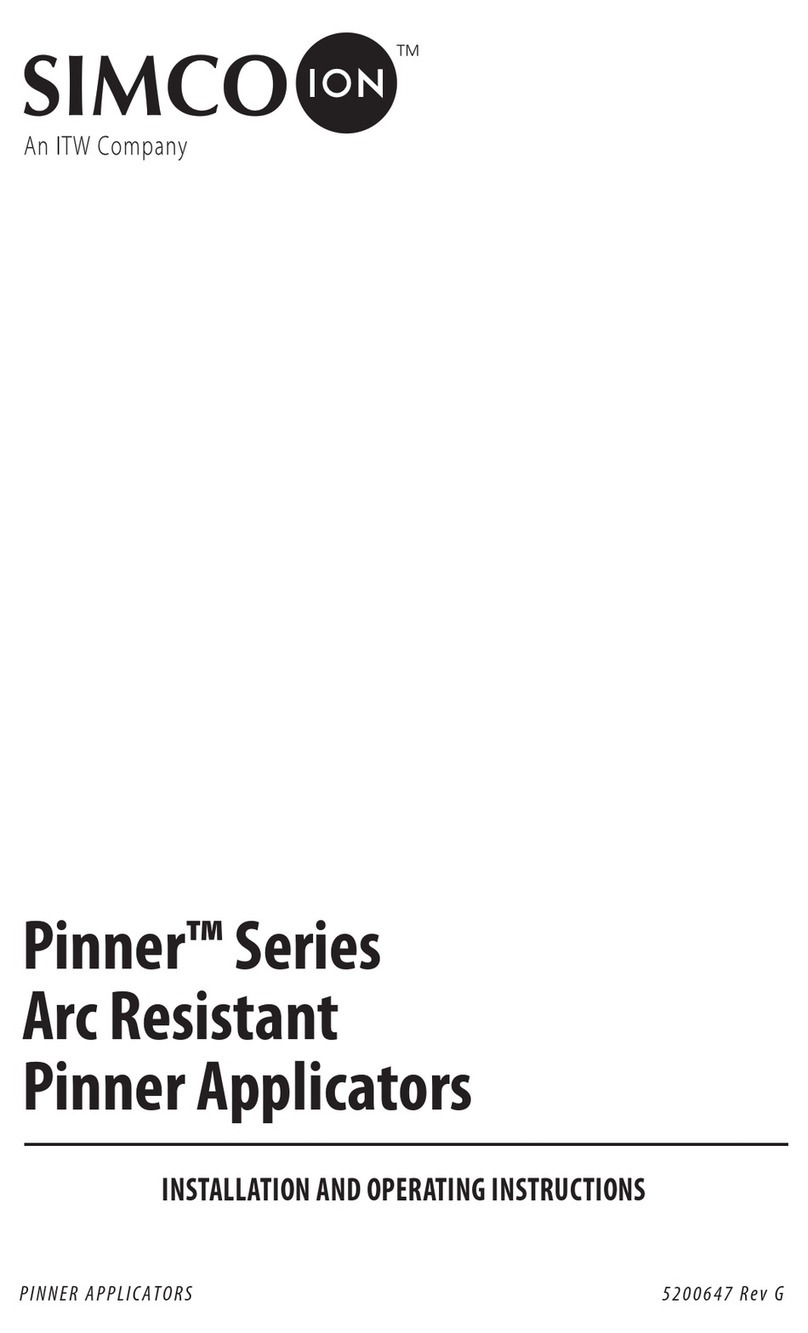
ITW
ITW Simco-Ion Pinner Series Installation and operating instruction
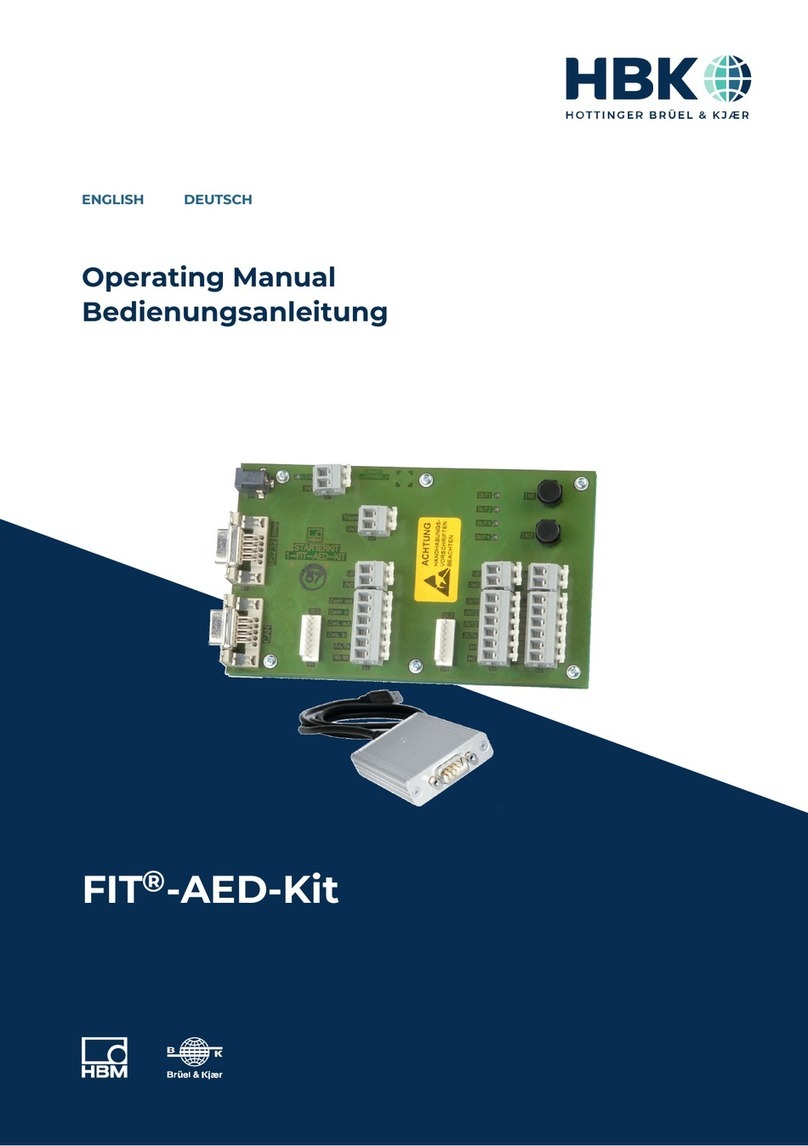
HBK
HBK FIT-AED-Kit operating manual
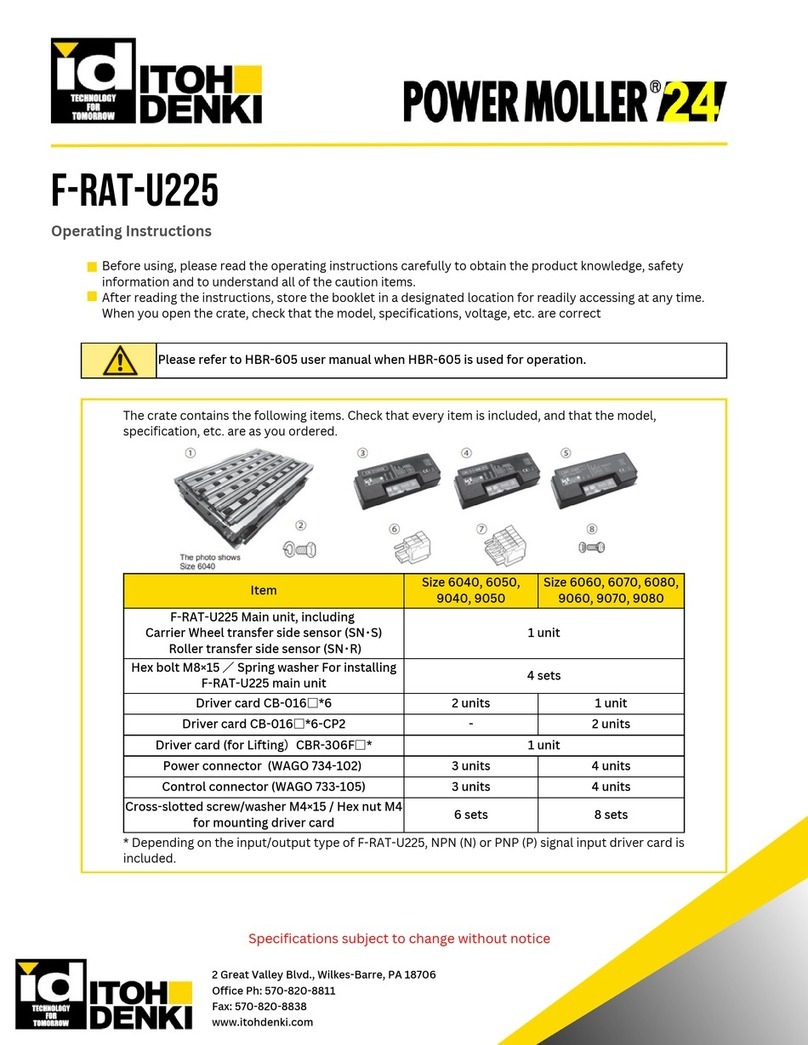
ITOH DENKI
ITOH DENKI POWER MOLLER 24 F-RAT-U225 operating instructions
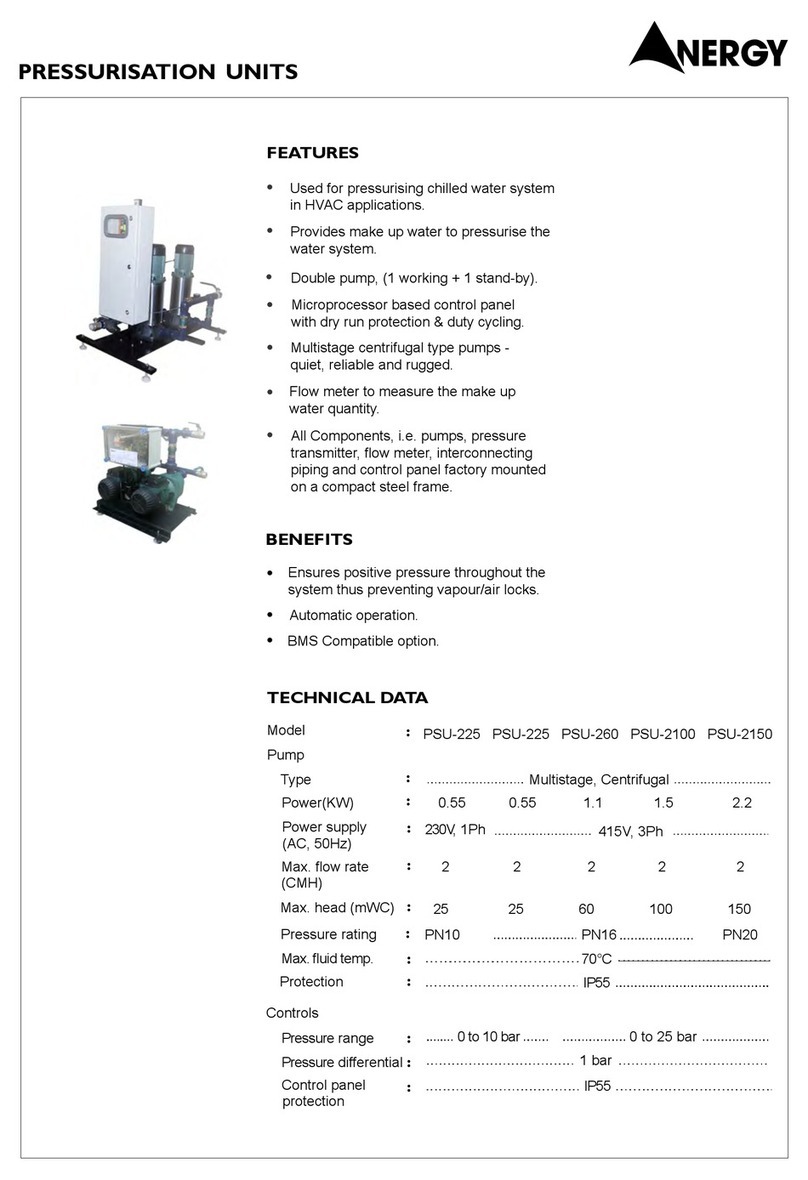
Anergy
Anergy PSU-260 Installation and commissioning
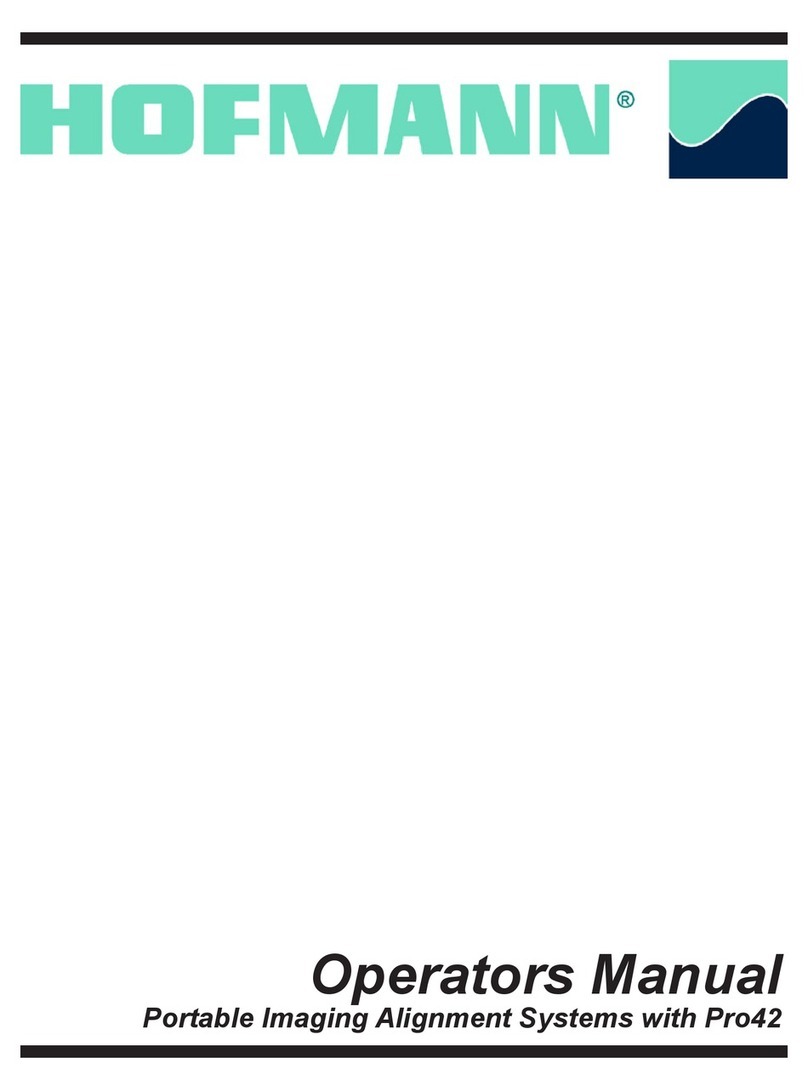
Hofmann
Hofmann Pro42 Operator's manual
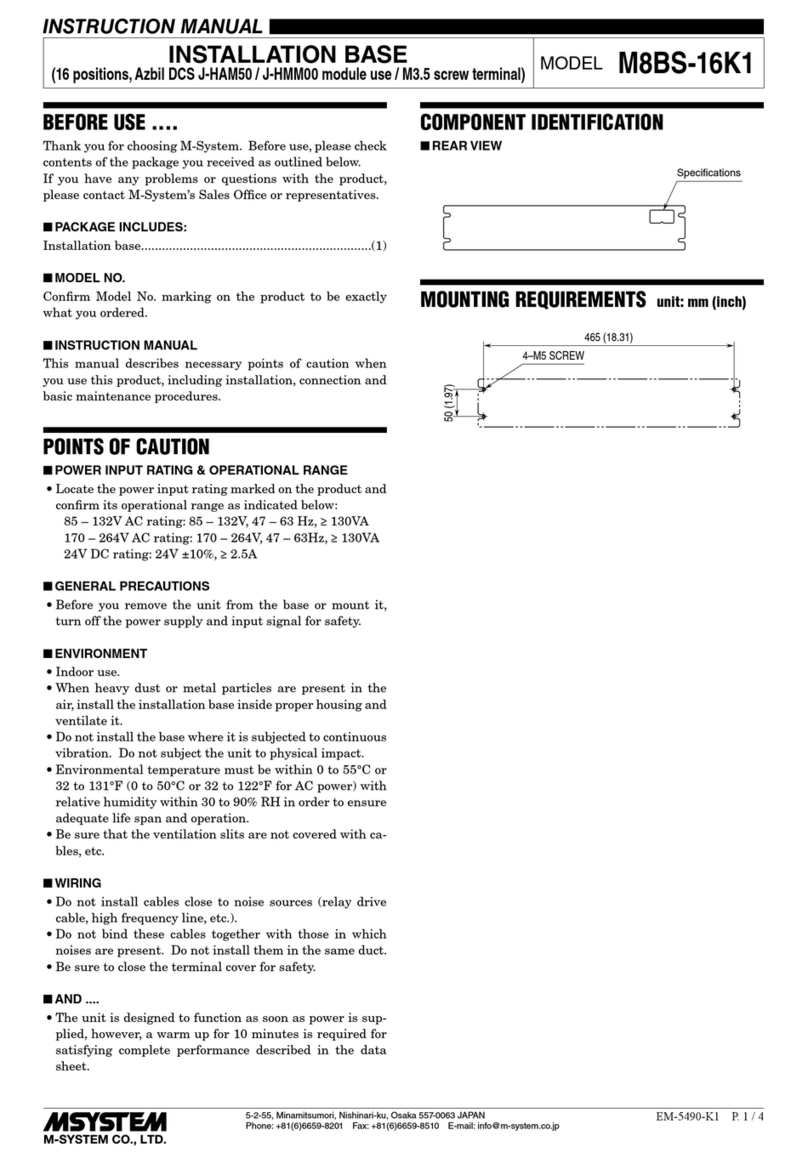
M-system
M-system M8BS-16K1 instruction manual

Giacomini
Giacomini GE551Y194 quick start guide
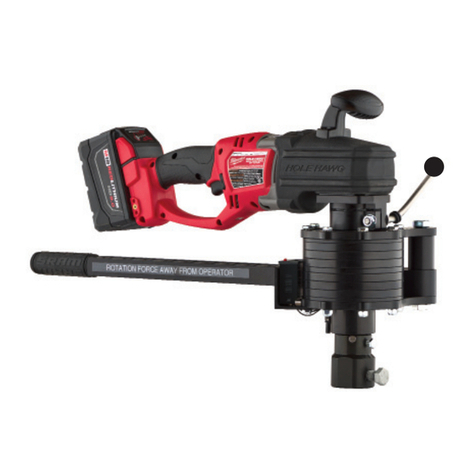
Hurco
Hurco HH500 Reference manual
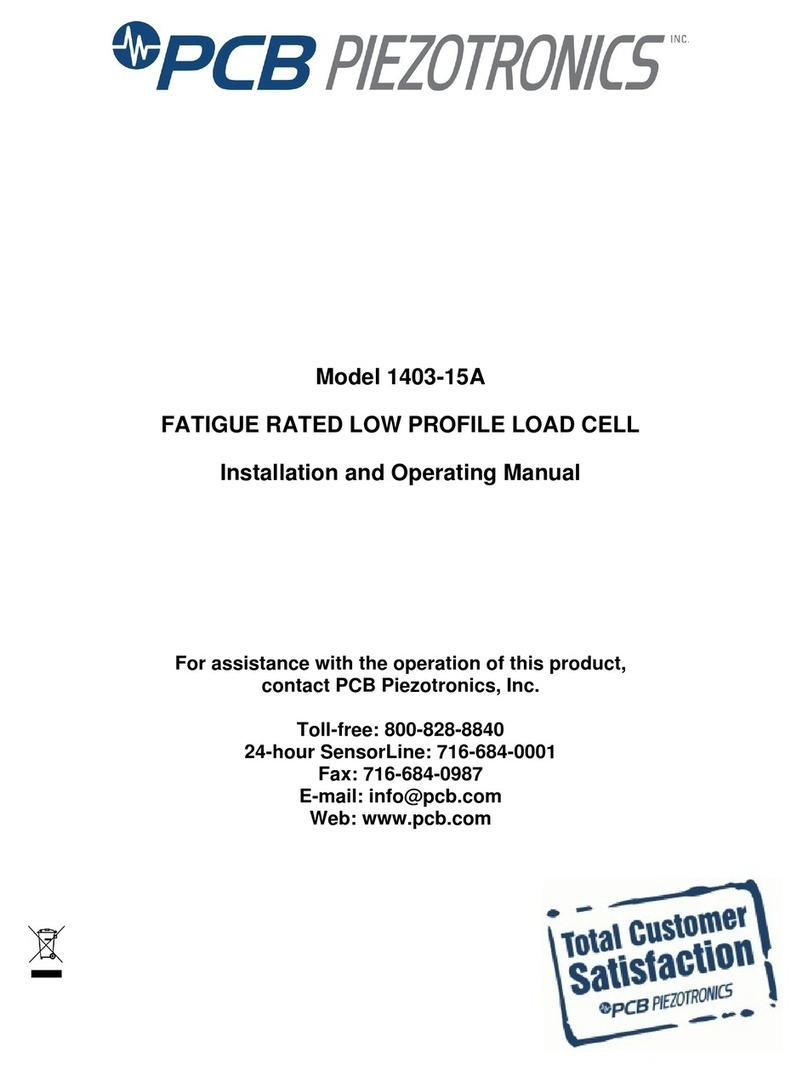
PCB Piezotronics
PCB Piezotronics 1403-15A Installation and operating manual

Parker
Parker D-Pak Installation and maintenance manual
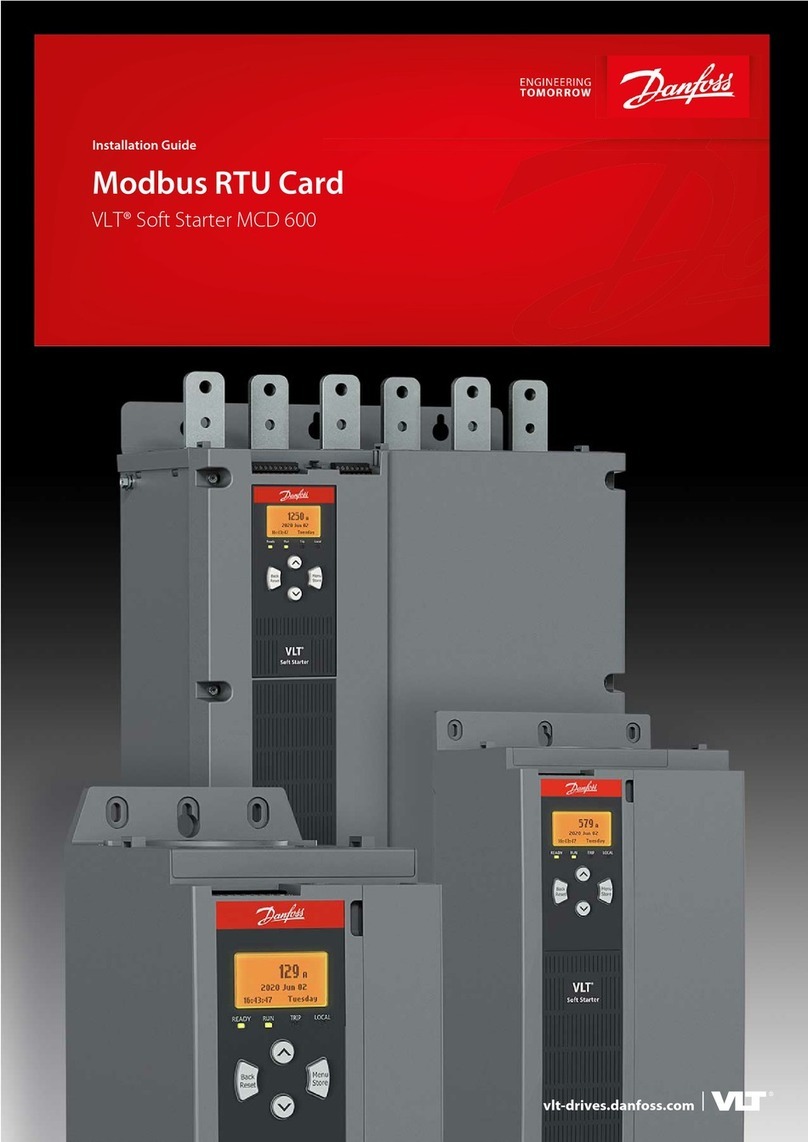
Danfoss
Danfoss VLT Soft Starter MCD 600 installation guide

